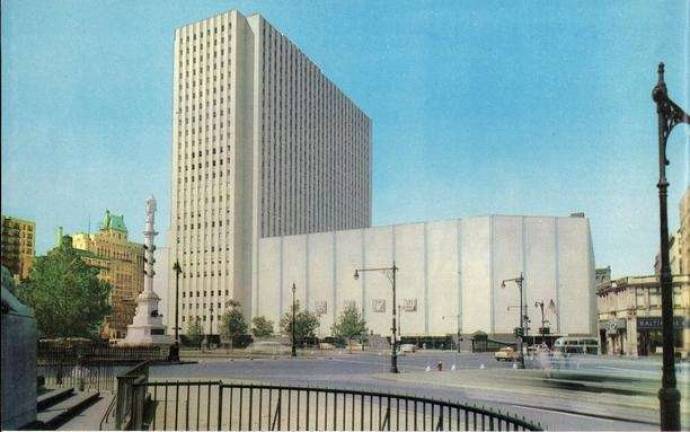Moses built NEW YORK’S COLISEUM

Before the Javits Center was New York City’s expo and convention center, the city’s chief venue for such events was the New York Coliseum on Columbus Circle.
The Coliseum was built in the mid-1950s by Robert Moses’ Triborough Bridge and Tunnel Authority and designed by architects Leon and Lionel Levy. It replaced two theaters, several tenements and office buildings and some stores.
To get it built, the powerful Moses condemned the west side of Columbus Circle as a slum, then got the federal government, under its slum-clearance program, to foot much of the bill. As it was being built in 1955, part of the main hall collapsed, killing one worker and injuring 50.
The Coliseum, which consisted of a windowless exhibition building and an attached 23-story office tower, was honored with a postage stamp when it opened in 1956. It was adorned with four medallions, representing the United States, New York State, New York City and the Triborough Bridge and Tunnel Authority. Mayor Robert Wagner called it “one of the wonders of the modern world.”
The architecture community, however, was less pleased with the bland, windowless structure.
“It’s a great utilitarian achievement, but architecture is something else again,” Frank Lloyd Wright was quoted as saying by The New York Times. “I think it’s all right for New York, but I hope it stays here.”
During the next 20 years or so, the Coliseum was the major exhibition hall in New York City. It could handle several events at once. It hosted were the New York International Auto Show, the National Photographic Show, the Philatelic Exhibition, the International Home Expo, the New York Coliseum Antiques Show, among others.
Eventually, however, trade shows got bigger and the New York Coliseum became inadequate. In the mid-1980s, construction started on the Javits Center, in Hell’s Kitchen, which further put the Coliseum’s future in doubt. The Coliseum closed in 1986 after a men’s sportswear show, and the MTA, which had become the parent body of the Triborough Bridge and Tunnel Authority, put the building up for sale.
After a planned sale to Boston Properties fell through in the early 1990s due to the recession, the MTA reopened the Coliseum for occasional small events, particularly the three-times-a-year antiques show.
The location had another function, as well. I remember, during the ‘90s, walking by and seeing a large crowd of people, mainly women with children, waiting for charter buses. A police officer on the scene told me the buses were taking them to upstate prisons to visit their family members.
Finally, in 1998, the MTA sold the building to Time Warner, which demolished it and built the Time Warner Center. Robert Moses in his heyday built many structures that are still part of the landscape of New York, but the Coliseum was not destined to be one of them.